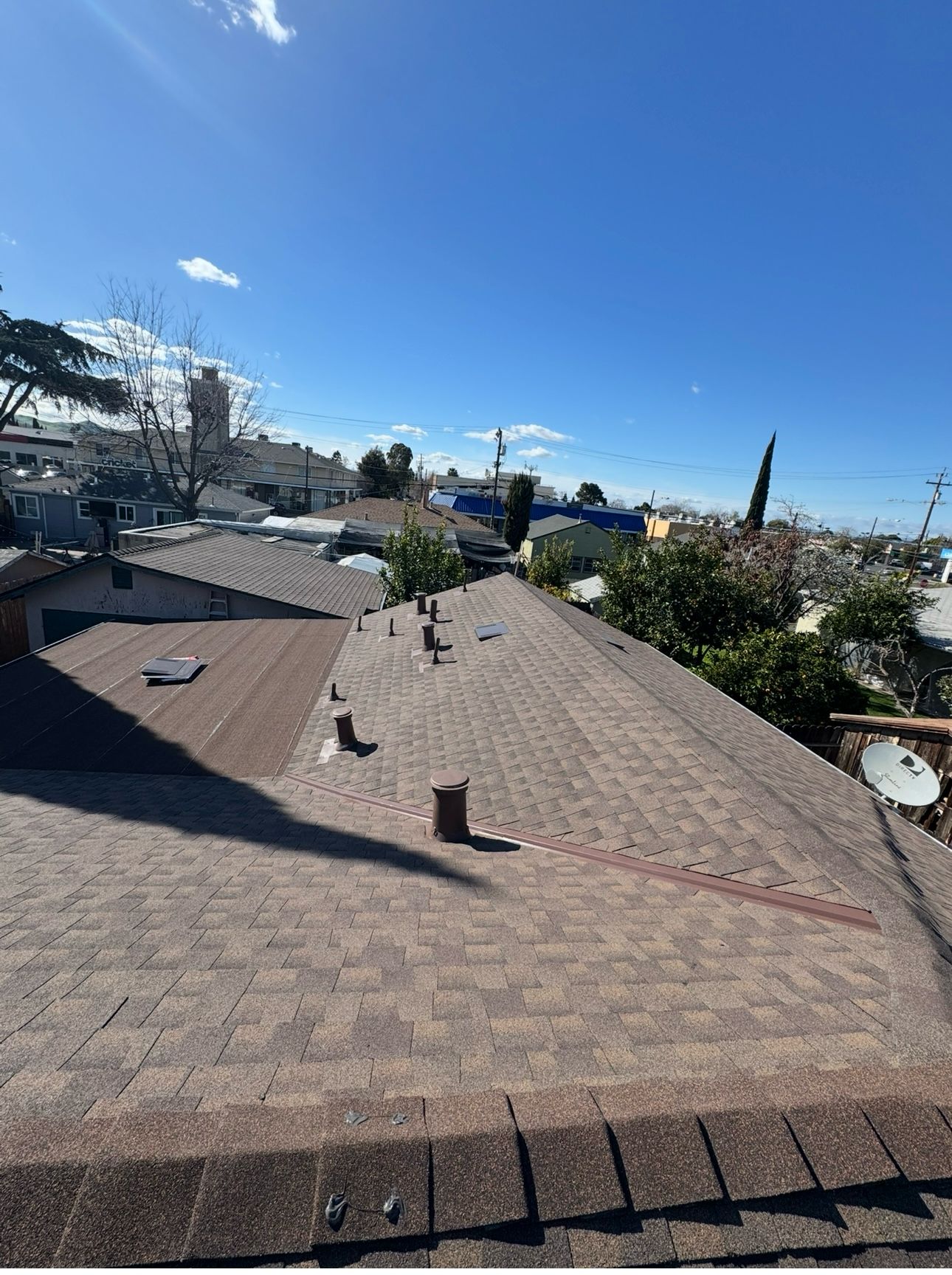Roof replacement is a significant undertaking, and it’s crucial to ensure that every aspect of the project is conducted correctly and in compliance with local regulations. One often overlooked but vital aspect of this process is obtaining the necessary permits. These permits are the guardians of safety, legality, and quality when it comes to roofing projects.
We are a leading roofing company with extensive experience in roof replacement, so if you have any questions after reading this, just give us a call and we’ll be happy to answer!
What Is a Roof Replacement Permit?
A roof replacement permit is an official authorization granted by local authorities that allows homeowners and contractors to proceed with an entire roof replacement project within specified guidelines. This permit serves as a crucial document in replacing and ensuring both safety and compliance throughout the roofing process. Whether you need to replace your roof, do a minor repair, or do a complete roof overhaul, understanding the necessity of this permit is paramount to the success of your repair or replacement roofing project. Below, we will explore the intricacies of roof replacement permits and underscore their essential role in every roofing project.
So, if you are a homeowner considering replacing your roof, searching for new roof installation or roof maintenance, in this guide you will find anything from permit to replace your entire roof system.
Why Do You Need a Permit for Roof Replacement?
You must understand the necessity of obtaining a permit for your roof replacement project. These permits are not just bureaucratic formalities, they serve critical purposes that directly impact your project’s legality, safety, and overall success.
Roof replacement permits are not imposed arbitrarily. There are several reasons for requiring permits:
– Legal Compliance. Permits are a legal requirement in most jurisdictions. Complying with local building codes and regulations is crucial to avoid legal issues and potential fines. Failing to do so can result in costly consequences down the road.
– Safety Measures. Roofing can be hazardous work. Commercial roofing and residential roofing permits ensure that safety standards are upheld during your project, reducing the risk of accidents and injuries. By requiring permits, authorities ensure that the work is carried out with the necessary precautions in place.
– Quality Assurance. Permits usually involve roof inspections by qualified professional inspectors. These inspections help maintain the quality of workmanship and make sure everything meets the required standards and is built to last regardless of the type of roof.
Permits help authorities monitor and control the construction process in several ways:
1. Permits require compliance with the local building code and standards, which are designed to safeguard structural integrity and safety.
2. Authorities assess the structural aspects of your roof replacement plans to ensure they meet safety and engineering standards, protecting both your home and its occupants.
3. Permits may also take into account zoning laws and aesthetic considerations, ensuring your project aligns with the overall look and feel of your neighborhood.
By complying with the permit process, you not only meet legal requirements but also invest in the long-term well-being of your home and those who reside within it.
How can you determine whether your project requires a permit?
Does my roofing project require a permit? That’s a very common question we get asked here at Golden Heights. Figuring out whether your roofing project mandates a permit may appear complex due to the labyrinth of regulations and guidelines. However, it doesn’t have to be a daunting task. Here are some clear-cut measures to assist you in ascertaining whether your particular project calls for a permit.
Consult with the local building department
Begin by consulting your local building department or authority. They typically provide information on whether building permits are required for various types of roofing projects. Check if there are specific guidelines related to roofing permits in your area.
How big is your roofing project?
The scope of your roofing project is a significant factor in permit requirements. Larger projects, such as complete metal roof replacements, are more likely to necessitate permits compared to minor roof repairs. Assess the square footage involved in your project, as some jurisdictions have size thresholds that trigger permit requirements.
What type of roofing work is required?
Review the nature of the work you’re planning. A permit is required in projects that involve structural changes, such as adding new layers, asphalt shingles, or altering the roof’s shape. Determine if your project includes installing new roofing materials, such as metal roofing which is heavier, or replacing a roof that may impact fire resistance, energy efficiency, or environmental regulations.
Seek advice from Golden Heights
Seek advice from roofing professionals or contractors with experience in your area, as they are often well-versed in local permitting requirements and can provide valuable insights. Roofing experts can assess your project and advise you on whether it falls under permit regulations.
Contact local permitting authority
When in doubt, contact your local permitting authority directly. They can provide specific information tailored to your location and project. Ask about the application process, required documentation, and associated fees for obtaining a roofing permit.
Check online
Many local government websites offer resources and FAQs to help homeowners obtain a roofing permit. Explore these resources before you request a permit to gain a better understanding of the permitting process in your area.
Check building exemptions
By following these steps and conducting thorough research, you can gain clarity on whether your roofing project requires a permit.
Remember that complying with permit regulations is essential not only for legal reasons but also for ensuring the safety, quality, and longevity of your roof replacement or repair. Proceeding with any heavy roof work without the necessary permits can be dangerous for your family’s safety!

When Is a Roof Replacement Permit Required?
A building permit is only required in specific cases, such as:
- Installing a brand-new roofing system;
- Conducting major repairs or structural improvements;
- Adding new roofing layers or materials;
- Changing the roof’s shape, pitch, or structure;
- Installing skylights or dormers;
- Roofing projects that impact drainage systems;
- Installing solar panels or satellite dishes.
What Happens if You Do a Roof Without a Permit
Undertaking a roofing project without the necessary permit may seem tempting, especially if you can save time and money. However, this decision can have serious consequences that far outweigh any perceived advantages. Here’s what can happen if you choose to do a roof without a permit:
Fines and penalties
You may face fines, penalties, or even orders to halt work until the required permits are obtained. In some cases, you might need to dismantle or redo parts of your roofing project to meet code requirements, resulting in additional costs.
You are responsible for accidents and injuries
If accidents or injuries occur during the project, you could be held responsible for any damages or medical expenses, as your work may not be covered by insurance due to the lack of permits.
Poor workmanship
Subpar workmanship can lead to costly repairs or even roof failure in the future.
Your property value decreases
Unpermitted work can have a negative impact on your property’s value. Prospective buyers may be hesitant to purchase a home with unpermitted improvements, as they could face the burden of addressing code violations. You may thus encounter difficulties when trying to sell your home, and it could remain on the market longer than anticipated.
Insurance company coverage
Insurance companies often have clauses that exclude coverage for work done without permits. In the event of roof damage or other related issues, you may find that your insurance provider refuses to cover the costs.
As you can see, attempting a roof replacement or repair without the required permit can lead to a cascade of problems, including legal repercussions, safety risks, compromised quality, and potential issues when selling or insuring your property.
Where to Obtain Roof Replacement Permits
While a roof replacement permit helps ensure the legality and safety of your roofing project, it’s common to feel lost between government offices. Here is how to navigate this process and secure these permits.
1. Local Government Offices
The primary authority for issuing construction permits, including roofing permits, is typically the local building department. You can start your permit application process by visiting or contacting this department.
In some areas, the planning department may also handle roofing permits, especially if the project involves changes to the roof’s structure or aesthetics. If your project affects zoning regulations, such as height or setback requirements, the zoning department may be involved in the permitting process as well.
2. Online Permit Portals
Many local government agencies have embraced digital platforms, offering online permit application systems. Check your municipality’s website to see if they provide this convenient option. It often allows you to submit applications and documents electronically, saving you time and effort.
3. Paper Applications
If online applications are not available, you can typically obtain paper permit applications from the relevant government offices. These applications should include all the necessary details on what’s required for a successful submission.
4. Permit Offices and Contact Information
You should visit your city or town hall, where you can ask about the permitting process and obtain application forms. In some cases, county-level offices may oversee permits for areas outside city limits.
Also, consult your local government’s official website. They often provide detailed information on permit requirements, along with contact information for the relevant departments. Local government websites typically list phone numbers for permit-related inquiries. If you’re unsure where to begin, call and ask for guidance!
5. Consultation Services
Some municipalities offer consultation services or permit experts who can guide you through the process, answer questions, and ensure your application is complete and accurate.
The permit application process may vary depending on your location, so research and verify the specific requirements for your area.
The Roof Replacement Permit Application Process
The roof replacement permit application process typically involves several steps to ensure that your project aligns with local building codes and safety regulations.
How to Apply for a Roof Replacement Permit
Here’s a step-by-step guide on how to apply for a permit, along with tips for a successful application:
Step 1. Contact the permitting authority and ask about the specific requirements for obtaining a roof replacement permit in your area.
Step 2. Gather the necessary documents and Information. This may include, among others:
- detailed project plans and specifications,
- proof of property ownership or authorization from the property owner,
- contractor information, including licensing and insurance details,
- a completed permit application form,
- any additional documents specified by the permitting authority.
Step 3. Complete the permit application form. Be sure to provide all requested details, such as project scope, location, and materials to be used.
Include your contact information so that the permitting authority can reach you for updates or inspections.
Step 4. Submit your completed permit application, along with all required documents and fees, to the permitting authority. This can typically be done in person at their office or online through their website if an electronic application option is available.
Step 5. The permitting authority will review your application to ensure that it complies with local building codes, zoning regulations, and safety standards. This review process may take some time, so be prepared for potential delays.
Step 6. If your application is approved, you’ll need to schedule inspections at key project milestones, such as before starting work and after completing the roofing project. These inspections ensure compliance with safety and quality standards.
Step 7. If the permitting authority identifies any issues during its inspections, make the necessary corrections promptly to align with the required standards.
Step 8. Once all inspections are successfully completed, you’ll receive final approval, certifying that your roofing project is compliant and safe.

Common Challenges and How to Overcome Them
Be proactive and address these common challenges. Seek guidance from Golden Heights when needed to streamline the permit application process for your roofing project.
| № | Challenge | Solution |
| 1 | Incomplete Documentation | Make sure you submit all required documents and information accurately. Review the permit application checklist provided by your local permitting authority to avoid missing any essential details. |
| 2 | Unclear Project Plans | Provide clear and detailed project plans, including architectural drawings and specifications. Professional drawings can make it easier for permit officials to understand your project, reducing the chances of delays. |
| 3 | Delays in Processing | Submit your application well in advance of your planned roofing project start date. Some authorities may experience high volumes of permit requests, so early submission can help you avoid unnecessary delays. |
| 4 | Insufficient Communication | Maintain open communication with the permitting authority. Don’t hesitate to seek clarification or guidance if you’re unsure about any aspect of the application process. Timely responses to any requests for additional information are crucial. |
| 5 | Discrepancies with Building Codes | Familiarize yourself with local building codes and regulations. Consult with a professional contractor or architect to ensure that your project aligns with these codes. Address any potential discrepancies before submitting your application. |
| 6 | Permit Denials | In case your permit application is denied, don’t panic. You have the option to appeal the decision. Here’s how:Review the denial notice carefully to understand the reasons for the rejection. Address the issues cited in the denial notice. Make the necessary changes or adjustments to your plans or documentation. Resubmit your revised application with the requested changes. Communicate with the permitting authority to ensure that your revised application addresses their concerns.If necessary, seek professional assistance or legal counsel to navigate the appeal process effectively. |
| 7 | Budget Constraints | Budget for permit expenses from the outset of your project. Include permit fees and any potential additional costs, such as expedited processing fees, in your financial plan. Proper budgeting can help you avoid unexpected financial strains. |
What to Expect During the Inspection Process
It’s good to know beforehand what to expect during inspections and what inspectors look for, as it helps you prepare and contributes to a successful roofing project. During roofing inspections, inspectors typically assess the following aspects:
- They check the structural components of the roof to ensure they can support the roofing materials and withstand environmental stresses.
- Inspectors verify that the roofing materials and installation methods comply with manufacturer specifications and local codes.
- They examine flashing details, seals, and penetrations (such as chimneys and vents) to ensure they are watertight and secure.
- Inspectors assess ventilation systems, as proper attic ventilation is crucial for preventing moisture buildup and ensuring energy efficiency.
- They check insulation levels and installation for energy efficiency and compliance with local requirements.
- They confirm that roofing materials meet fire resistance standards, particularly in areas prone to wildfires.
- They assess the roof’s drainage system, including gutters and downspouts, to prevent water accumulation and potential damage.
Expert Tips for a Hassle-Free Permit Process
Tips and advice are always helpful, especially if it’s the first time you apply for a roof replacement permit. Here are some tips from industry professionals Golden Heights Roofing to ensure a hassle-free permit approval:
1. Start the permit application process well in advance of your planned roofing project. Early preparation allows time for any unexpected delays or revisions.
2. Thoroughly research local building codes, zoning regulations, and permit requirements specific to your area. Knowing the rules is the first step to compliance.
3. Engage a licensed roofing contractor or architect experienced in your locality. Their knowledge of local regulations and best practices can be invaluable.
4. Provide clear and detailed project plans, including architectural drawings and specifications. Clarity in your plans helps permitting authorities understand your project’s scope.
5. Ensure all documents, including permit applications, are accurate and complete. Errors or missing information can lead to delays or denials.
6. Maintain open and regular communication with the permitting authority. Promptly respond to any requests for additional information or revisions.
7. Professional architectural drawings can simplify the review process. Consider hiring an architect or draftsman to create detailed plans if necessary.
8. Prepare your roofing project for inspections from the outset. This includes adhering to safety standards and following manufacturer guidelines.
9. If time is of the essence, inquire about expedited processing options with your permitting authority. Be prepared to pay the associated fees.
10. Maintain meticulous records throughout the permit process. Keep copies of all correspondence, permits, and inspection reports.
11. Prioritize safety throughout your project. Ensure that all workers have proper safety gear and fall protection systems in place.
12. Seek guidance from reliable resources such as local government websites, permitting authority handbooks, and industry associations for additional insights into the permit process.
13. Consider reaching out to local construction or roofing associations. They often provide resources, seminars, or networking opportunities to help navigate permitting challenges.
14. Familiarize yourself with the appeal process in case of permit denials. Consult with a legal or construction professional if needed.
These expert tips can increase the likelihood of a smoother, hassle-free experience.
Ready to Have Your Roof Replaced?
As a general rule, getting a permit helps ensure that the job meets the local building codes and standards, so it’s advisable to have an inspector review the work to validate its quality and adherence to safety norms. Navigating the permit process for a roof replacement or minor repairs is a crucial step to ensure the job is done right.
At Golden Heights Roofing, we strive to make this process as hassle-free as possible for our clients. Our licensed contractors have the right tools and expertise to not only replace a roof but also handle gutter installation efficiently.
We understand that you might have numerous questions like, ‘How can I replace my roof?’, ‘How can I get a permit?’, or ‘Who can apply for it on my behalf?’. Our website serves as a platform to answer many of these queries. Moreover, our adept roofers are always ready to assist you through each step of the process. Remember, doing things the right way from the get-go saves time, money, and ensures your peace of mind.
Do you need a roof repair or have questions about replacing a roof? Do you need a roofing expert company to help with your house-building permits? Feel free to contact us today for a seamless roof replacement experience. Whether you are looking to get a permit, need minor repairs, or want to replace your roof, ordering our services will guarantee a job done right.
Reach out to us today and take the first step towards a hassle-free roof replacement journey!
Frequently Asked Questions
How would I know if a building permit was “issued” for a roof replacement?
Reach out to your local permitting authority via phone, email, or in-person visit, providing them with the necessary project details. Alternatively, you can inspect your permit documentation for indications of issuance, such as a permit number and an expiration date, or consult your roofing contractor if you’ve enlisted their services for the permit application process.
How much does it cost to obtain a permit for a roof replacement?
Permit fees can vary based on location, project size, and specific requirements.
What permit is necessary for roof replacement?
The specific permit necessary for a roof replacement can vary depending on your location and local building codes. In most cases, a roofing permit or a building permit that covers roofing work is typically required to ensure that the project complies with safety and construction standards. Check with your local permitting authority or building department to determine the exact permit requirements and application process for your roof replacement project.
What are the fines if there is no permit for a roof replacement?
The fines for not having a permit for a roof replacement can vary widely depending on your location and local regulations. In some areas, fines can range from a few hundred to several thousand dollars, and may escalate if corrective actions are not taken to legalize the work.
How can I check to see if there was a permit pulled for roof replacement?
To check if a permit was pulled for a roof replacement, you can typically contact your local permitting authority or building department. Reach out to them by phone, email, or in-person visit, providing the project details such as the address and any reference numbers associated with your permit application. Some local governments also offer online permit tracking systems on their official websites, where you can input your application information to check the permit status.


